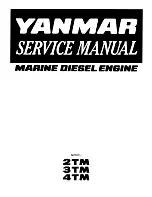
7.9
Section 7
Electrical System and Components
7
Figure 7-8. Check For Timing Advance.
a. If the line on the screen moved away from
the line on the blower housing during
acceleration, the DSAI ignition module
for the cylinder being tested is working
properly. If it didn’t move away, go to Test 4.
b. If you were able to check timing on both
cylinders, the lines you made on the blower
housing should be 90° apart. If not, go to
Test 4.
Test 4. Test the Ignition Modules and Connections
1. Remove the blower housing from the engine.
Inspect the wiring for any damage, cuts, bad
crimps, loose terminals, or broken wires. Check
that connections are oriented properly on
terminals of modules.
2. Disconnect the leads from the ignition module(s)
and clean all of the terminals (male and female)
with aerosol electrical contact cleaner to remove
any old dielectric compound, dark residue, dirt,
or contamination. Disconnect the spark plug
leads from the spark plugs.
3. Using a multi-meter, check that a proper ground
is established between the ground (black) lead of
the DSAI module (closest to spark plug lead), and
a known good ground location on the engine.
4. Turn the key switch to the ON position and
check for 12 volts at the center/power (red) lead
terminal of the DSAI module. Use the same
ground location for the multi-meter as in Step 3.
a. If all tests are OK and module has no spark
or fails to advance, replace the a
ff
ected
module.
b. If any of the tests are bad; determine cause
and
fi
x as required, then retest.
Battery Charging System
General
Most engines are equipped with a 15, 20, or 25 amp
regulated charging system. See Figures 7-9 through
7-15.
NOTE: Observe the following guidelines to
avoid damage to the electrical system and
components:
• Make sure the ba
tt
ery polarity is correct. A
negative (-) ground system is used.
• Disconnect the recti
fi
er-regulator plug and/or
the wiring harness plug before doing any electric
welding on the equipment powered by the
engine. Also, disconnect all other electrical
accessories in common ground with the engine.
• Prevent the stator (AC) leads from touching or
shorting while the engine is running. This could
damage the stator.
Summary of Contents for Comand Pro CH1000
Page 1: ...SERVICE MANUAL HORIZONTAL CRANKSHAFT CH940 CH1000...
Page 2: ......
Page 4: ......
Page 30: ...4 4 Section 4 Air Cleaner and Air Intake System...
Page 52: ...6 6 Section 6 Lubrication System...
Page 96: ...8 16 Section 8 Disassembly...
Page 110: ...Section 9 Inspection and Reconditioning 9 14...
Page 140: ...10 30 Section 10 Reassembly...
Page 141: ......
















































